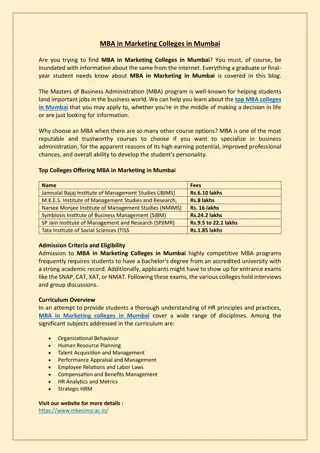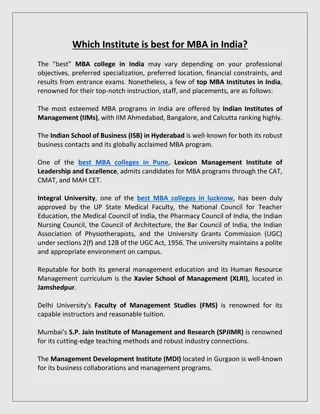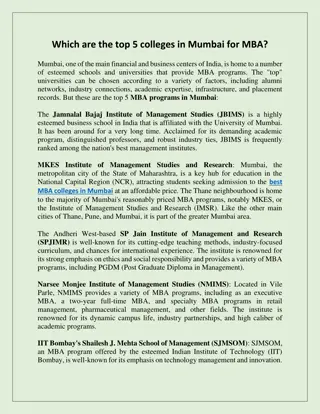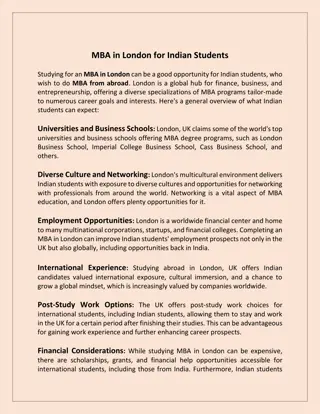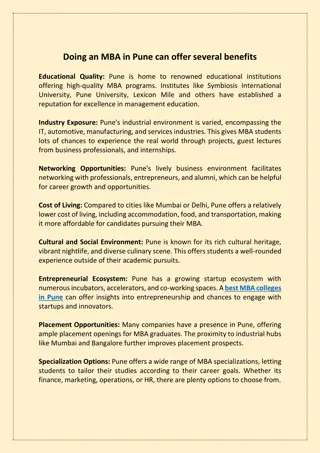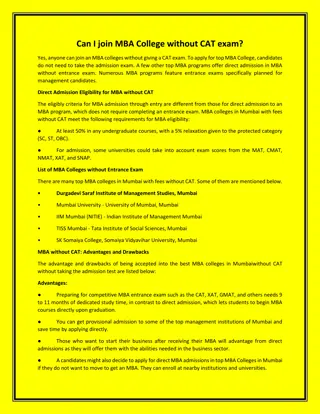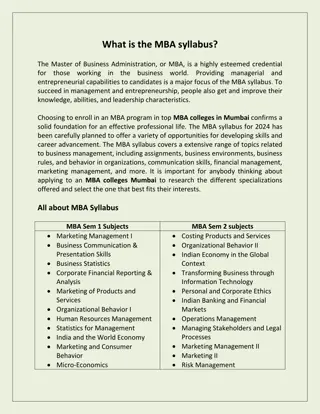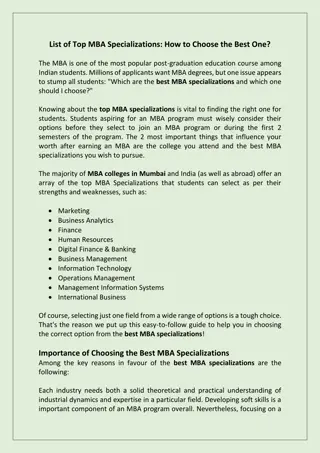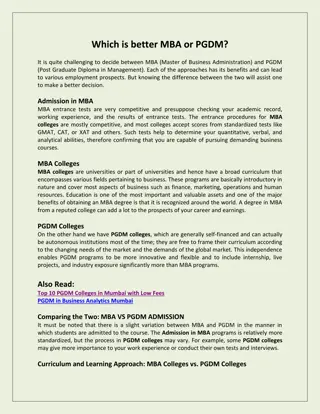
Concept and Importance of Strategy in Business Management
Explore the concept of strategy in business management, its features, and the crucial role it plays in achieving organizational objectives. Learn about the key aspects such as direction, action plans, trend identification, resource allocation, and decision-making framework. Enhance your understanding of strategy's dynamic nature and its impact on business success.
Download Presentation

Please find below an Image/Link to download the presentation.
The content on the website is provided AS IS for your information and personal use only. It may not be sold, licensed, or shared on other websites without obtaining consent from the author. If you encounter any issues during the download, it is possible that the publisher has removed the file from their server.
You are allowed to download the files provided on this website for personal or commercial use, subject to the condition that they are used lawfully. All files are the property of their respective owners.
The content on the website is provided AS IS for your information and personal use only. It may not be sold, licensed, or shared on other websites without obtaining consent from the author.
E N D
Presentation Transcript
Strategy Armaan Salik J Assistant Professor Jamal Institute of Management
Concept of Strategy Strategy refers to the course of action which is required to achieve the objectives of an organisation and implement its goals. In other words, strategy is a means to achieve goals. According to Schendel and Hatten, the definition of business strategies is the basic goals and objectives of the organisation; the major plan of action chosen to reach its goals as well as objectives .
Features of Strategy Generally, strategies are long run-in nature as they help to understand the path towards the future as well as its impact on present activities. However, in some cases, strategies may be made for a shorter period. Strategy mainly defines the course of action of a business in general, which an organisation needs to follow in order to achieve its objectives. Another important component of strategy is that it is dynamic in nature, and it needs to be changed or modified according to changing times and conditions. Strategy provides a proper combination of external and internal factors that can affect the ability of an organisation to perform activities towards well-established goals. Strategies are formulated mainly by top-level managers and directions are provided to the middle and lower-level managers to frame sub-strategies. Strategy allows businesses to beat their competition by distributing scarce resources efficiently across different regions, resulting in optimal utilisation. Strategies are forward-looking because they are developed and implemented with the goal of achieving the firm s goals in the future.
Importance of Strategy 1. Direction and Action Plans: A strategy gives an organisation the appropriate course to follow in order to meet its objectives. It provided a clear and detailed action plan for achieving the targeted position in the future. The company receives comprehensive guidance on how things will be done and goals will be met. 2. Identification of Trends and Opportunities: Strategy helps to identify various market trends and future opportunities available to a business organisation. It helps in examining the different variations in the market like that of social, political, as well as customer changes and technological changes. Once the market changes have been identified, the firm develops certain tactics so that the business can adjust to the future changes. 3. Defining Accountability: Strategy helps to define accountability in a business enterprise. It also helps in setting the timelines in order to attain certain results on the strategic initiatives. 4. Improving Communication and Commitment: With a proper well-defined strategy, the level of communication, as well as commitment in the organisation, get enhanced as it helps in clarifying the accountability as well as vision. With a proper strategic plan, all the activities of businesses are aligned to safeguard the commitment.
Importance of Strategy (Contd) 5. Allocation of Desired Resources: Every firm, large or small, must allocate resources correctly. Since resources are limited, strategy determines which goods, services, and markets will be included in the company s future and which will not. This guarantees that resources are efficiently utilised, resulting in maximum output for the company. 6. Framework for Decision-Making: A strategy helps in providing a proper framework regarding decision-making for a particular firm. Also, a strategy provides a reference point on the basis of which organisations can make decisions to ensure sustained business growth. 7. Competitive Advantage: By establishing strategies, businesses can get a competitive advantage over their competitors. Businesses can have a better understanding of themselves and their future goals. In this manner, resources are efficiently used, and everything runs smoothly, resulting in maximum productivity for the company.
Types of Strategy Corporate Level Strategy: Corporate-level strategies are generally defined by senior management and include the long term objectives as well as influence the business units working under it. Business-Level Strategy: These are strategies which are framed at the business unit level by a senior manager, which includes building a certain competitive advantage for the firm. Functional Level Strategy: Functional strategy refers to strategies within a business enterprise that mainly focus on certain functional areas like that of marketing, sales as well as production. Operational Level Strategy: These are strategies that are formed in the operating units of a company and are mainly developed by field-level managers. It mainly focuses on creating implementable plans for acting on business strategies.
Strategic Framework An organisation needs a strategic framework as a roadmap for building a business. It offers a clear plan to help your business grow through its vision, mission, core values, and objectives, providing a sense of direction and purpose. Strategic frameworks are tools used in business to highlight plans to reach future goals and objectives. They define how a business or organisation department implements projects and initiatives to support the overall business vision of stakeholders.
Strategy frameworks can be used for various goals, such as: Developing brand awareness Building and expanding new market and niche sectors Adopting sustainable practices in business operations Building a solid customer base Limiting long-term debts within 5 years of the timeframe
Importance of Strategic Framework Aligns Team Efforts: A strategy framework builds goals and methods by helping team members stay motivated and focused on common objectives to achieve the same purpose. Attracts Stakeholder Support: A defined strategic framework can motivate investors or broad members by contributing funds and attracting new investors over time. Limit Unnecessary Costs: With a clear strategy framework, organisations can allocate costs efficiently and avoid spending on initiatives that don t contribute to vital goals. Boosts Employee Motivation: It helps employees connect with the purpose of their tasks and increases motivation by showing them how their work helps the organisation achieve success. Enhances Timely Task Completion: A strategy framework helps businesses stay on schedule by cooperating with deadlines, assisting them in saving money, fostering healthy relationships, and driving stable growth.
Key Elements of a Strategic Framework Vision Statement Purpose: It defines long-term goals for the organisation by outlining what it aims to achieve in the future. Key Aspect: It provides a motivational guide and offers a sense of purpose for all stakeholders. Mission Statement Purpose: It broadens the scope of the organization's core purpose and primary objectives that it aims to achieve. Key Aspect: It finds the organization's role in the market and achieves a value proposition to customers and clients. Core Values Purpose: Builds the beliefs and principles that guide the organization's Behaviour and helps in making informed decision making. Key Aspect: Core values influence company culture and help shape its brand identity.
Key Elements of a Strategic Framework Objectives and Goals Purpose: Define measurable and specific outcomes the organisation aims to achieve over a particular time frame. Key Aspect: Objectives are insightful and actionable steps needed to achieve broader goals that are aligned often with the vision and mission. Strategic Priorities Purpose: Identify key areas that are important to achieving organisational objectives. Key Aspect: The strategy framework has straight priorities that help you allocate resources efficiently and concentrate efforts on impactful activities. Key Performance Indicators (KPIs) Purpose: Offers measurable metrics to track the progress towards achieving objectives and goals. Key Aspect: KPIs help organisations evaluate the effectiveness of their strategy and make informed data-driven decisions.
Key Elements of a Strategic Framework SWOT Analysis (Strengths, Weaknesses, Opportunities, Threats) Purpose: A comprehensive understanding of the internal and external factors influencing the organisation s strategy. Key Aspect: SWOT analysis helps identify competitive areas and potential challenges. Action Plan Purpose: Highlight the specific tasks, timelines, resources, and responsibilities required to implement the strategy. Key Aspect: The action plan ensures that strategy initiatives are translated into actionable steps. Resource Allocation Purpose: Determine allocating operational, financial, and human resources to get support for strategic initiatives. Key Aspect: A practical resource allocation ensures that the necessary resources are in place to implement the strategy successfully. Review and Evaluation Purpose: Involves assessment of strategy framework to ensure it remains aligned and relevant to the organisation s goals. Key Aspect: Review and evaluation are the elements that include periodic reviews and adjustments to strategies based on performance and changes within the business environment.
Benefits of Implementing a Strategic Framework Alignment Across the Organisation: A defined strategy framework ensures that all departments and employees work on the same objectives. This alignment ensures collaboration, mitigates conflicts, and upgrades efficiency. When everyone understands the organisation s goals and how a role contributes to achieving them, it creates a sense of motivation and purpose. Enhanced Decision-Making Process: A strategy framework offers a precise context of decision-making. Leaders can use strategic goals and fundamental values to make insightful choices consistent with the organisation s long-term growth, providing a sense of confidence and security in their decisions. Adaptability and Resilience: Organisations must be adaptable to thrive and survive in a business landscape. A strategic framework helps facilitate flexibility while focusing on long-term objectives. Organisations can respond to market, technology, and external environment changes by regularly reviewing and updating the framework. Effective Communication: A strategy framework allows effective communication and transparency within the organisation. Leaders can keep everyone engaged and informed by articulating the vision, mission, initiatives, and goals. This communication helps build trust and fosters stakeholder engagement aligned with the organisation s strategy.
How to Develop a Strategy Framework? 1. Define Objectives: Start with defining the goals and objectives of the organisation. 2. Select a Framework: Choose the proper strategy framework, such as a SWOT analysis and balanced scorecard, that suits your organization's needs. 3. Collect Data: Gather data about the internal and external operations of the organisation. 4. Analyze Information: Analyze the data using the framework and identify strengths, opportunities, weaknesses and threats. 5. Strategy Formulate: Build strategic initiatives based on analysis. 6. Develop Action Plans: Create specific actions, assign responsibilities and set timeframes. 7. Monitor and Implement: Execute and implement the strategies and monitor progress to ensure alignment with defined goals.
How Do You Win With a Strategy Framework? Select the Right Framework: Choosing the right framework that aligns with the industry s goal. Thorough Analysis: Make an informed and comprehensive analysis of internal and external factors that are affecting your organisation. Make Clear Goals: Set specific, measurable, realistic, achievable and time-bound objectives. Build Action Plans: Make informed and detailed action plans with concise responsibilities and timelines. Implement and Monitor: Execute and implement plans regularly and monitor progress by adjusting. Stakeholders Engagement: Involve stakeholders throughout the process to ensure successful implementation.
Process of Strategy Formulation Defining Mission and Vision: - This foundational step articulates the organization s core purpose (mission) and long-term aspirations (vision). The mission serves as a guiding principle, delineating the organization s raison d tre and the value it intends to offer. Concurrently, the vision paints a picture of what the organization aspires to become. It serves as a beacon guiding its strategic decisions and actions. Together, they form the cornerstone influencing the organisation s culture, direction, and goals.
Setting Objectives Once the mission and vision are defined, the next step is establishing concrete objectives aligning with them. These objectives are specific, measurable, achievable, relevant, and time-bound (SMART). It serves as milestones that the organization aims to achieve within a specified timeframe. Setting clear objectives is crucial as it provides a focused direction. It enables the organization to channel its efforts effectively towards achieving its mission and realizing its vision. Example: A startup setting a SMART objective to achieve a 20% market share in its niche within the first five years of operation, aligning with its mission to become a leader in its industry and its vision to revolutionize its sector with innovative solutions.
Strategy Development At this juncture, teams brainstorm and develop various strategies. It considers the organization s strengths, weaknesses, opportunities, and threats (SWOT). This stage is crucial for laying a solid foundation for the forthcoming steps. It ensures the strategies are grounded in a deep understanding of internal and external environments. Example: Amazon is leveraging its technology and logistics competency to expand into new markets and product categories.
Implementation Planning This phase is characterized by meticulous Planning to pave the way for the successful implementation of the chosen strategy. It encompasses delineating responsibilities, setting realistic timelines, and allocating necessary resources. A well-crafted plan at this stage serves as a blueprint for action in the subsequent phase. Example: Tesla outlining a detailed plan for the rollout of its electric vehicle charging infrastructure, including timelines, budget allocations, and partnerships.
Strategy Implementation Strategy implementation implies the transition of strategy from paper to practice. The organization mobilizes its resources to execute the plan, adjusting based on real-time feedback and changing circumstances. This stage is vital for translating strategic visions into tangible actions and achievements. Example: Starbucks is implementing its strategy of expanding globally by opening stores in various countries and adapting its menu to suit local tastes.
Monitoring and Control This stage involves continuously monitoring the strategy s performance to ensure alignment with the organization s objectives and the dynamic market conditions. It allows for timely interventions and adjustments, helping to maintain the strategy s effectiveness and relevance in a fluctuating business environment. Example: Coca-Cola regularly monitors the performance of its marketing campaigns and makes adjustments based on consumer feedback and market trends.
Feedback and Adjustment Feedback is a pivotal aspect of this phase, where inputs from various stakeholders are collected and analyzed. This facilitates necessary adjustments to the strategy. It ensures it remains attuned to the evolving needs and preferences of the market, thereby sustaining its effectiveness and relevance. Example: Apple gathering feedback on the initial version of its iOS software. It makes adjustments based on user suggestions and identified issues.
Review and Assessment This final step involves periodic reviews to assess the strategy s effectiveness. It allows for a comprehensive evaluation and necessary recalibrations. This ensures the strategy aligns well with the organization s goals, fostering continuous improvement and steering it towards its envisioned success. Example: Samsung conducts a periodic review of its smartphone strategy. This is done to assess its effectiveness and make essential adjustments to stay competitive.
Globalization and Sustainability in Strategic Management Overview: The global business environment is rapidly changing, influenced by globalization and sustainability. Globalization has expanded markets, supply chains, and competition worldwide. Sustainability has become a key priority for companies to ensure long-term profitability and address environmental, social, and governance (ESG) concerns. Importance for Strategic Management: Strategic management today must account for both global expansion and sustainable practices to maintain a competitive edge.
Understanding Globalization in Strategic Management Globalization refers to the integration of markets, cultures, and economies around the world, driven by advancements in technology, trade, and communication. Key Drivers of Globalization: 1. Technological Advancements (e.g., the internet, AI, automation) 2. Trade Liberalization (e.g., WTO agreements, regional trade blocs) 3. Cultural Exchange (e.g., digital media, global talent mobility) 4. Global Supply Chains (e.g., offshoring, outsourcing) Impact on Strategic Management: 1. Market Expansion: Opportunities to enter new markets and increase revenues. 2. Increased Competition: Need to innovate and differentiate products. 3. Operational Efficiency: Economies of scale and resource optimization.
The Role of Sustainability in Strategic Management Sustainability refers to the ability of organizations to operate in ways that meet the needs of the present without compromising the ability of future generations to meet their own needs. Triple Bottom Line (TBL): 1. Economic: Profitability and financial performance. 2. Environmental: Minimizing environmental impact. 3. Social: Corporate social responsibility (CSR) and community development. Sustainability Drivers in Business: 1. Consumer Demand: Growing preference for eco-friendly and socially responsible products. 2. Regulations: Increasing governmental focus on environmental standards and social equity. 3. Long-Term Profitability: Sustainable practices can lead to cost savings, risk reduction, and enhanced brand loyalty.
Strategic Approaches to Globalization Global Standardization Strategy: Offering the same products or services worldwide to benefit from economies of scale. Example: Apple s global branding and product offerings. Localization Strategy: Tailoring products or services to fit the local market s preferences, culture, and regulations. Example: McDonald's adapts its menu to local tastes (e.g., McAloo Tikki in India). Transnational Strategy: A hybrid approach combining global efficiencies with local responsiveness. Example: Coca-Cola s standardized brand image but localized marketing strategies.
Sustainability Integration in Global Strategies Integrating Sustainability into Core Strategy: 1. Sustainable innovation: Develop eco-friendly products (e.g., electric cars by Tesla). 2. Green supply chains: Partnering with suppliers who uphold environmental standards. 3. Circular economy: Reducing waste by reusing and recycling resources (e.g., IKEA s recycling initiatives). Examples of Companies Leading in Sustainability: Patagonia: Strong commitment to environmental protection through sustainable sourcing and activism. Unilever: Sustainability goals in sourcing, production, and product life-cycle management. Competitive Advantage through Sustainability: 1. Brand Loyalty: Consumers increasingly support companies with strong sustainability practices. 2. Cost Efficiency: Sustainable practices like energy-saving measures and waste reduction can lead to significant cost savings.
Challenges in Globalization and Sustainability Globalization Challenges: 1. Cultural Sensitivity: Adapting to different cultural norms and consumer behavior. 2. Geopolitical Risks: Political instability or trade barriers impacting international operations. 3. Supply Chain Complexity: Managing global supply chains with diverse regulations and environmental considerations. Sustainability Challenges: 1. Balancing Profit and Sustainability: Pressure to deliver short-term financial results while investing in long-term sustainability. 2. Greenwashing: The risk of companies misrepresenting their environmental impact to boost their image. 3. Supply Chain Transparency: Ensuring ethical and sustainable practices across complex, global supply chains.
Aligning Globalization and Sustainability in Strategic Management Framework for Integrating Both: Global Market Expansion: Enter new markets with products that meet both local needs and sustainability standards. Sustainable Global Supply Chains: Partner with suppliers who prioritize sustainability, ensuring that operations adhere to environmental and social governance (ESG) criteria. Innovation and Technology: Use technological advancements to enhance both global reach and sustainability (e.g., blockchain for transparency in sourcing). Key Strategic Considerations: Long-Term Focus: Ensure sustainability is a long-term commitment rather than a short- term initiative. Collaboration with Stakeholders: Engage suppliers, customers, and local communities in sustainability efforts.
Case Study: Teslas Globalization and Sustainability Strategy Globalization: Tesla has expanded its presence across multiple continents with manufacturing plants in the U.S., China, and Europe. Adapted its marketing strategies to cater to different regulatory environments and consumer preferences. Sustainability: Tesla s focus on clean energy and electric vehicles aligns with its mission to reduce global carbon emissions. Innovation in battery technology and solar energy solutions supports sustainable energy practices globally. Strategic Takeaways: Integration of sustainability into core mission: Tesla uses sustainability as a differentiator in a globalized market. Global growth strategy with local adaptations: Adaptation to different markets, while sticking to a unified, sustainable message.
Conclusion Key Takeaways: Globalization presents both opportunities and challenges in strategic management. Sustainability is no longer optional; it is a key driver for long-term business success. The integration of globalization and sustainability can provide competitive advantages and help create value for stakeholders. Future Outlook: Businesses must continue to evolve strategies to adapt to global changes while prioritizing sustainable practices. Strategic management will need to balance profitability with environmental and social responsibilities to thrive in an increasingly globalized and eco-conscious world.



